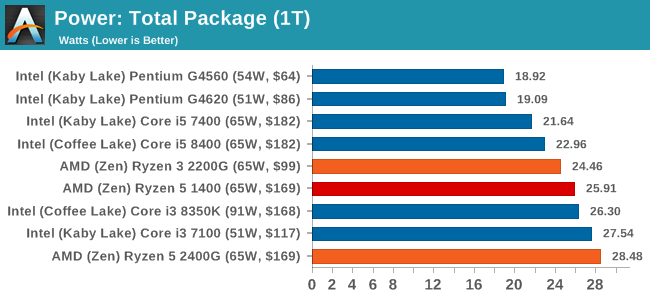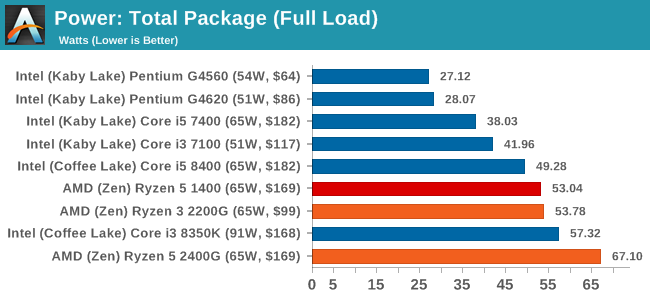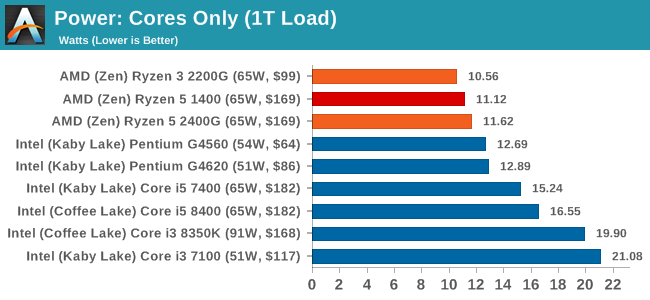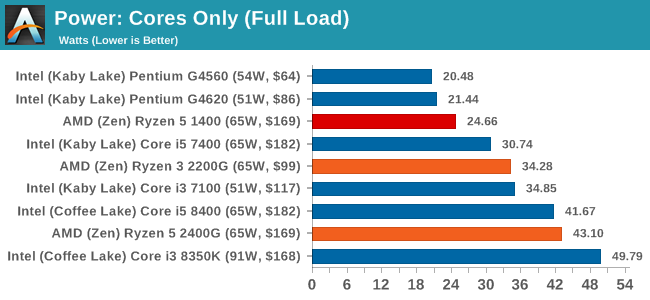Marrying Vega and Zen: The AMD Ryzen 5 2400G Review
by Ian Cutress on February 12, 2018 9:00 AM ESTPower Consumption
For our power consumption metrics, we use a Prime 95 blend on fixed threads to generate a strong load, and then poll the internal power registers that determine power state calculations to get the power consumption. Each processor is different in how it reports its power, which depends on the level of control the processor has: some of the more advanced CPUs, such as Ryzen, will provide per-core power numbers, while the latest Intel CPUs only give a figure for the CPUs as a whole but also include DRAM controller and uncore power consumption.
An interesting element to the power consumption on the Ryzen APUs, due to the unified power delivery subsystem in play feeding the CPU and the integrated graphics, is that the power registers only report half the power consumption when probed (e.g. when 14W, shows 7W). As of yet, we are unsure if this has a knock-on effect on how the processor adjusts its turbo modes in response to power consumption. Nonetheless, a simple scaling factor gives the following results.
Total Package: The Whole Processor
For this data, we take the values of the processor as a whole, which includes all the interconnect, memory controllers, PCIe root complexes, etc. The system is still only loading the CPU cores with minimal effect on the rest of the system, however depending on how the power is managed, some of the sub-systems still remain enabled.


At full load, the difference between the Ryzen 5 and the other Ryzen CPUs shows that the 2400G is using more of its upper margin, compared to the 1400 which is rated at the same power (note TDP is only determined at the base frequency), but the extra frequency of the 2400G means that there is extra power draw overall. Part of this is due to the Infinity Fabric, which we will see below. But what these tests also underline is that in a quad-core configuration, the Intel CPUs are still very power efficient.
Cores Only: Pure Work
For the processors that split out the data, we can look at the power consumption of the cores on their own, without any of the sub-systems, like uncore, mesh, or infinity fabric. This usually paints a different picture to the package power.


For the core only power, the Ryzen 5 2400G uses less power than the Core i3-8350K, despite the situation being reversed when considering the whole package. This means that Infinity Fabric takes a lot of power here, and the ring bus solution that Intel uses benefits from being simpler, and Intel can push more power to its individual cores.










177 Comments
View All Comments
SaturnusDK - Saturday, February 17, 2018 - link
On the subject of allocated VRAM. It should be set as low as possible. The minimum is 64MB. You should never set it higher. Since VRAM is system RAM there is no speed gains to be had in GPU performance setting it higher than the minimum and just letting windows sort out the spill over but you are potentially limiting the CPU performance a lot as allocated VRAM eats available system RAM, so if you have 8GB but set VRAM to 2GB, the system only have 6GB remaining. This can seriously hurt performance in some cases. So, as little VRAM as possible is the correct setting.minidea - Tuesday, February 20, 2018 - link
<p><a href="http://www.minidea.co.in ">Minidea</a></p>Titoboyer24 - Saturday, February 24, 2018 - link
This Is Really A Great Stuff For Sharing. Keep It Up .Thanks For Sharing. <a href="http://www.mechanicalassignments.com/">Mec... Engineering Homework Help</a>Titoboyer24 - Saturday, February 24, 2018 - link
Get The Dissertation Writing Service Students Look For These Days With The Prime Focus Being Creating A Well Researched And Lively Content On Any Topic. Mechanical Engineering Homework Help http://www.mechanicalassignments.com/ ............Titoboyer24 - Saturday, February 24, 2018 - link
Only Professional Writers Can Make This Kind Of Material, Cheers<a href="http://www.spsshelponline.com/">SPSS Homework Help</a>
IntoGraphics - Friday, March 9, 2018 - link
For Ryzen 5 2400G + X370 mATX m/b.What 16GB (4x4GB) and 32GB (4x8GB) kits memory modules (brand + model) would easily overclock much higher than DDR4-2933 for the best GPU performance ?
(I'm looking at some 4000MHz kits but if that is not compatible it will be a waste.)
andrewbaggins - Tuesday, May 1, 2018 - link
Anandtech reviews continue to show us what the graphics chips CAN'T do well instead of what they CAN do well. I've heard all the reasons before, and they don't help. Gaming benchmarks should be presented for PLAYABLE settings rather than can-just-barely-run-it settings, i.e. High/Ultra. No gamer will settle for jerky, stuttery gameplay, so why not show us what the items under review can do on, say, Medium settings with a few High setting benchmarks thrown in for good measure?